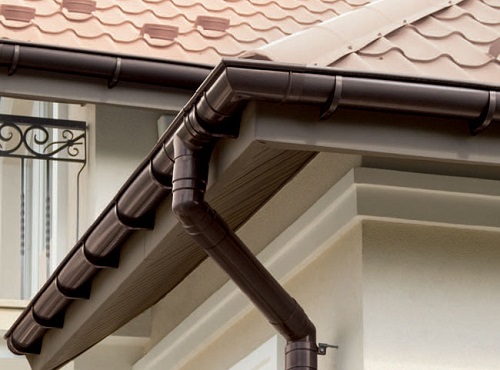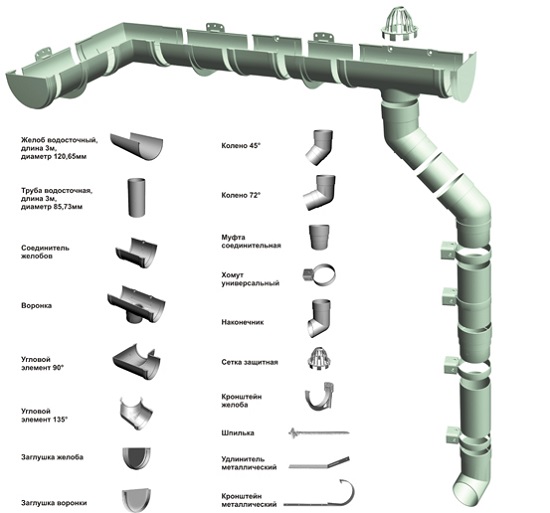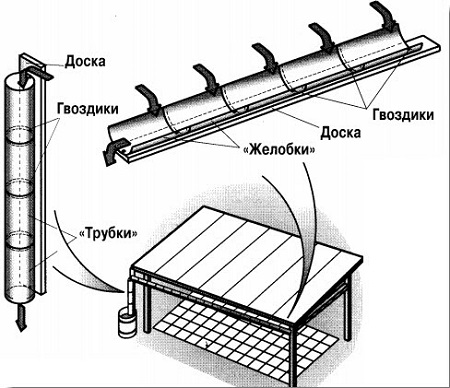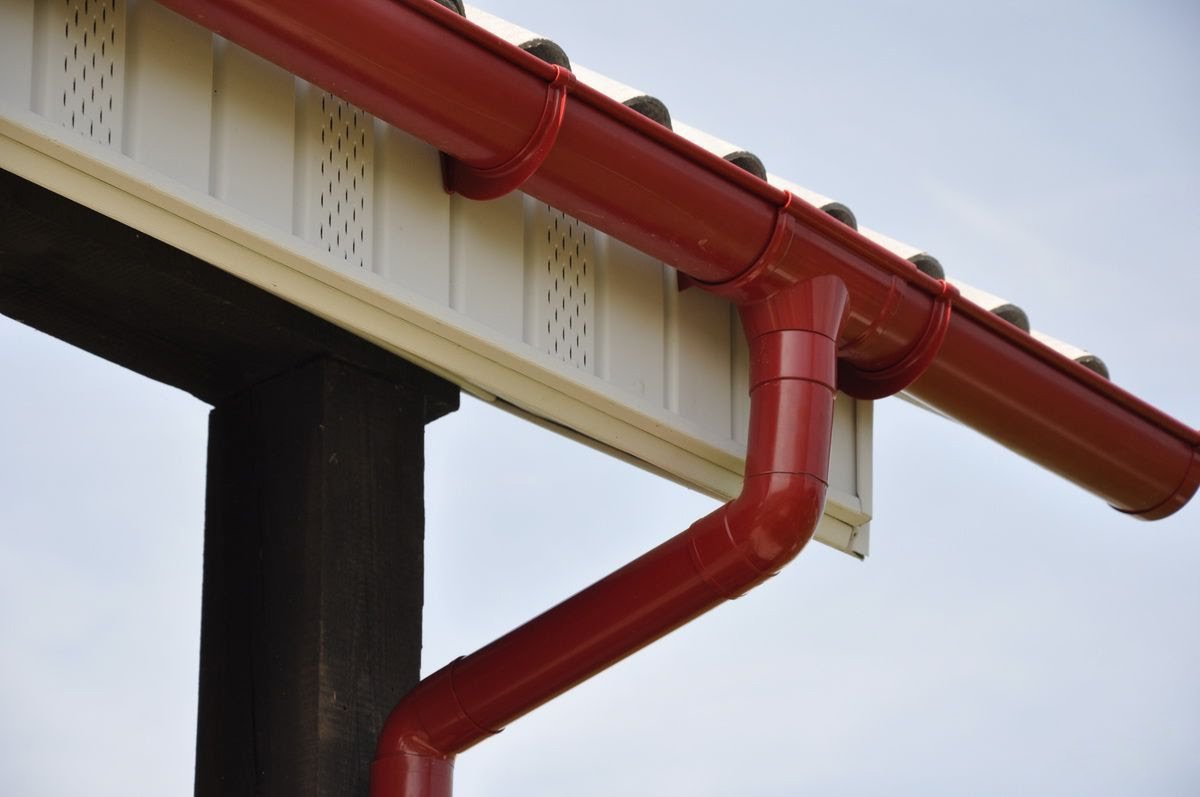For thousands of years, people have been fleeing from bad weather inside houses, protected from cold, wind and rainfall, but the buildings themselves also require certain systems that allow them to perform their functions for a long time. For example, plastic gutters, completely resistant to various types of atmospheric influences, are an important element for ensuring a long service life of a house or structure.

Before talking about the plastic variety of such products, it is necessary to clarify a number of terms that are used to describe this or that structure of this type. So the gutter system is a collection of individual blocks and elements installed on the facade and roof. It is designed to solve problems such as protecting the building from the effects of rainfall and reducing the amount of water that penetrates the foundation of the house. Thanks to a properly constructed gutter, precipitation is collected and brought to the places of runoff.
Content
What the gutter system consists of
Usually, any plastic structure is assembled according to a certain technology using standard elements. Below we will consider each of them and its functions separately:
- Gutter. This is a channel that collects water flowing down the roof slopes and directs it to the next element of the systems. Its main functions are: providing foundation protection, preventing soil erosion near the blind area, maintaining the decorative appearance of the facade. If you do not use the gutter, then the entire mass of water flowing along the slopes will fall on the walls due to gusts of wind, which means that they will gradually get wetter and stronger, so their service life may decrease.

Ground erosion; foundation protection are equally important problems. Even having made plastic gutters with your own hands, you will provide some protection for these elements. I must say that without using them, as well as with an improperly made blind area, water will get to the foundation or soak the soil around it. In the case when the blind area is correctly and extremely reliable, there is a risk that not just dirt, but a real swamp will appear around the building.
- Drainpipe. This element has been familiar to us all since childhood, and even today they are a “weak link” of various buildings that are on the balance sheet of the municipality. To avoid such problems, it is recommended to use precisely plastic, rather than metal elements, and the roof structure should be appropriate. The pipe is mounted vertically and is most often located on the wall of the structure. It is assembled from links, mounts and connectors.
- Gutter drain. This element is installed in the gutter and is designed to connect it to the pipe. In fact, it is a coupler that is mounted to other elements forming a gutter.
- Mounting elements. They include various types of connectors, brackets, plugs and other elements.
The task of the pipe connector is to create a single pipe, increase the length of the path that the water passes, connect the pipe with a special outlet.

All elements are fixed using special brackets mounted on the wall. In general, the gutter holders are of two types - long and short.The first is designed to preserve the geometric dimensions of the entire structure in any conditions, and the second is necessary for attaching gutters to the roof and creating additional support.
Drains made of plastic represent a modern solution and are very different from those products that were mounted to solve the problem of water drainage at the end of the last century. Of course, relatively little time has passed, but only today technologies have become available that allow you to create a design that has virtually no flaws.
Plastic gutters for roofs and their advantages

First of all, it is necessary to say about the reliability of such products. This is one of the most important points, since even with a low cost of the entire system, repairing it can be quite difficult. From this point of view, galvanized steel products no longer seem so attractive, and plastic, on the contrary, has all the necessary qualities. For example, the service life of plastic reaches 25 years, and during this period, all structural elements retain their characteristics, requiring minimal maintenance.
Climatic stability is an equally important property. Under the influence of water and air, metal is covered with rust and only a thin layer of special coating protects steel from this. Obviously, one small but deep scratch is enough and the metal will turn into an unsightly something in a couple of years. Plastic does not require any protection and is able to work in a wide temperature range. The main feature of modern pipes is resistance to UV radiation, which negatively affects many synthetic materials.

Typically, plastic elements for creating a drain can work at temperatures from -40 to +50 C, and their surface has very low adhesive properties, so ice does not accumulate here.
Drains plastic completely correspond to modern requirements and can have various appearance. This question is also relevant, since such a design is an important element of the exterior decoration and can both decorate the facade of the house and spoil the impression of elegant architectural solutions and the right choice of finishing material. Plastic opens up more opportunities for designers, so the finished result will surprise you. I must say that here there is the opportunity to choose the right color, and the shape can vary within wider limits.
Modern manufacturers of synthetic materials for creating drainage systems can offer a very wide range of colors and shades. Usually this allows you to achieve the perfect combination of the system and structural elements or, conversely, make it almost invisible against the background of the walls of the building.
The fourth advantage of plastic products is their exceptional weight. It is so small that it simply makes no sense to compare such products with metal. Obviously, such elements are much easier to mount than heavier steel structures.

In order to properly assemble a system of galvanized pipes that will last a long time, you need to have the skill of similar work and certain knowledge, and even a layman can cope with plastic, and this will not affect the drainage service life in a negative way. Detailed instructions are attached to any set of products made of synthetic material, which allows you to quickly understand the method of connecting elements and avoid common mistakes.
In addition to standard solutions, there are various designs created by your own hands. At first glance, many of them seem ridiculous, but some of these products have every right to exist. In this article we will talk about the most interesting option, which involves the use of not standard units and elements, but plastic bottles.
Drain from plastic bottles

This is a rather interesting option, which can be used for a variety of outbuildings on the site, outbuildings or small country houses. Before starting work, you need to stock up with a sufficient number of plastic bottles. The necessary amount of “raw materials” can be easily calculated, because only the central part of the bottle, which is about 20 cm, will be used.

Since the water should drain in the drain under the action of gravity, we recommend that you use only those bottles, the central part of which does not have protrusions, terrain and other obstacles. Otherwise, in winter, the formation of a thick ice crust may begin, which can lead to the filling of the entire structure with ice, and then destroy it.
To complete the work you will need:
- Plastic bottle. Typically, in such cases, a PET bottle having a cylindrical middle portion is used. It is better to choose a dark color, because against its background various garbage or streaks will not be noticeable.
- Construction stapler. This element is necessary for connecting individual elements together. The connection is overlapped, the value of which is not more than 1 cm.
- Scissors and a knife. They will be required in order to “disassemble” the bottle into elements for the system. The flat cylindrical central part will be used as a horizontal gutter or will become part of the branch. Instead of plugs that do not allow water to pass further, bottles are used, the back of which was not removed, but kept in place.
- Wire. A wire is required to connect the structural elements to the roof. Those who still use slate can make holes on the edges of the sheets for installing the drainage system, and on the side of the system itself, the fasteners are small wire rings threaded through holes in the walls of the drains.

The drain from plastic bottles, although it seems at first glance rather unreliable, even tolerates an ice test with honor. Moreover, it is noticeable that at the slightest thaw, the ice in the system begins to melt quickly, but metal pipes cannot boast of this.
Summing up, we note that plastic has much more advantages than metal. There is even one feature that is not obvious at first glance, which is that the plastic structure does not even scratch you when dropped, and a thin metal pipe or chute will become an unpleasant surprise if it falls on your head.





Alas, no comments yet. Be the first!